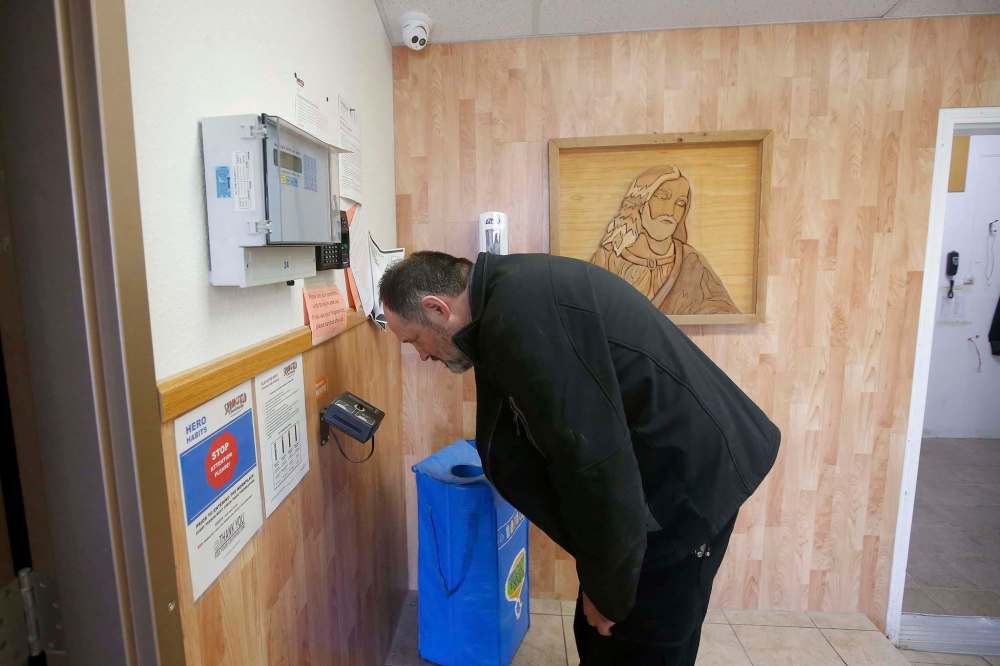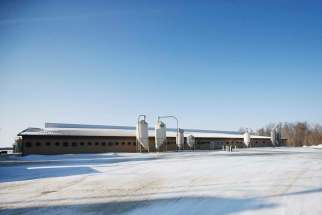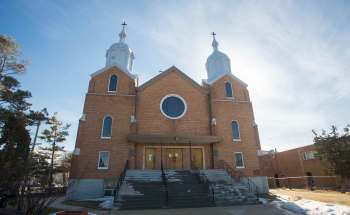Suspicion and stress in Springfield Colony members faced stigma along with sickness during COVID outbreak last summer; they want Manitobans to know they did everything to keep others safe
Read this article for free:
or
Already have an account? Log in here »
To continue reading, please subscribe:
Monthly Digital Subscription
$0 for the first 4 weeks*
- Enjoy unlimited reading on winnipegfreepress.com
- Read the E-Edition, our digital replica newspaper
- Access News Break, our award-winning app
- Play interactive puzzles
*No charge for 4 weeks then price increases to the regular rate of $19.00 plus GST every four weeks. Offer available to new and qualified returning subscribers only. Cancel any time.
Monthly Digital Subscription
$4.75/week*
- Enjoy unlimited reading on winnipegfreepress.com
- Read the E-Edition, our digital replica newspaper
- Access News Break, our award-winning app
- Play interactive puzzles
*Billed as $19 plus GST every four weeks. Cancel any time.
To continue reading, please subscribe:
Add Free Press access to your Brandon Sun subscription for only an additional
$1 for the first 4 weeks*
*Your next subscription payment will increase by $1.00 and you will be charged $16.99 plus GST for four weeks. After four weeks, your payment will increase to $23.99 plus GST every four weeks.
Read unlimited articles for free today:
or
Already have an account? Log in here »
Hey there, time traveller!
This article was published 08/03/2021 (1737 days ago), so information in it may no longer be current.
There were those long days in July, right at the height of the outbreak and the media spotlight that followed, when it seemed to Pauly Kleinsasser as if a dark cloud had crept over the Springfield Hutterite colony, where he has always lived, and from there to the wider Hutterite community beyond.
Families were getting sick. Reporters were on the phone. On those days, Kleinsasser, 50, watched the Brokenhead River babble along the edge of the colony, a community of 108 people about 60 kilometres east of Winnipeg along Highway 15, and felt “very depressed,” he says, thinking about the challenge the community was facing.
He wrote a song, called Go Away COVID, and submitted its lyrics to the local Clipper Weekly newspaper.
“I’m shackled and bound, I wanna get free, how long you’ll stick around is a mystery,” he wrote. “Some day you’ll be beat, a vaccine will be found, and COVID, you’ll leave and won’t be around… we’re all in this together, so be strong my friend. Have faith in God, we’ll make it. Amen.”

By then, he had already recovered from his own bout with the virus. In late June, Kleinsasser, who co-founded the colony’s Springfield Woodworking business, had gone to Alberta on one of his frequent work trips. Shortly after he returned, he started to feel sick and very weak. In the coming days, he lost 15 pounds.
He didn’t think it could be COVID-19, he says, but he got a test and it was positive. His was one of the first cases in what became a wave of colony outbreaks in Manitoba. Within days Springfield had 20 confirmed cases and four people were hospitalized; all recovered. Other colonies were not so lucky and lost lives to the virus.
Yet the outbreak at Springfield held one distinction. Of all the colonies that experienced COVID-19, it was one of just two named in the media, and the source of most outside attention. The news leaked out within hours of Kleinsasser receiving his test result. Before long, reporters were waiting at the end of the colony’s road. Residents spotted a drone overhead.
“The media was so crazy. The writeups they had about us, and the Hutterites…” Kleinsasser says. He trails off and shakes his head.

That focus, Kleinsasser and others around the colony say, came with some stress and frustration. They worried the attention would negatively impact their biggest business, Springfield Woodworking, which manufactures custom bath and kitchen cabinets and employs 55 workers from outside the colony, a large number for a Hutterite business.
To be safe, they shut down the plant for three weeks and enlisted an outside company to review and develop safety procedures, including temperature checks and mask guidelines. None of the outside workers tested positive for COVID-19 and, to be safe, they made a new rule that only workers could walk through the shop.
Still, the impact of the outbreak in Springfield rippled beyond its boundaries.
Rob Ringland, Springfield Woodworking’s plant manager, had friends ask why he kept working there. Others seemed worried to come near him. Once, on the way into work, he saw reporters camped out on the road; the media attention frustrated him, especially as he saw the wider impact it was making in the community.
“I thought that was horrible. Because (people) don’t know the Hutterite lifestyle, there’s a lot of misconceptions to start with…. If somebody was camped outside my house, saying this is the Ringland family, and this is where COVID is, I would be fuming. I’d be livid.” – Rob Ringland, Springfield Woodworking’s plant manager
“I thought that was horrible,” says Ringland, who is not Hutterite. “Because (people) don’t know the Hutterite lifestyle, there’s a lot of misconceptions to start with…. If somebody was camped outside my house, saying this is the Ringland family, and this is where COVID is, I would be fuming. I’d be livid.”
The province never identified impacted colonies by name. But it did, for a brief period, release when cases were connected to “communal-living communities.” In this spotlight, Hutterite word-of-mouth swirled with reports of members facing stigma when they left the colony to shop, including glares and harsh words.
While the actual news stories “weren’t as bad” as they feared, Kleinsasser says, they still seemed to increase the negative perception. (It didn’t help when, months later, photos circulated of an unrelated religious group that also wears plain clothing attending an anti-mask rally in Steinbach; some misidentified that group as Hutterite.)
To James Kleinsasser, one of Springfield’s two ministers, it felt as if there was little they could do to change the situation. “The damage had been done,” he says.

They opted to focus on taking care of their community and let leaders with the Hutterian Safety Council, an advisory body, deal with media.
Still, sometimes they wished the rest of Manitoba understood what steps they’d taken to contain the virus.
“We were very, very cautious,” James Kleinsasser says. “It wasn’t like we were sloppy, or had a don’t-care attitude. That was not the case.”
As the outbreak in Springfield wore on, there were days when that dark cloud that Pauly Kleinsasser felt seemed to open up enough to let the sunlight through. In the end, he says, the community pulled together to take care of each other, and that was a sort of learning experience, too.
With many families having to quarantine, others stepped up in masks and gloves to deliver meals, or help out with yard work. One of the colony’s two ministers drove around, checking in to see how folks were doing. And on some evenings, families brought guitars out onto their lawns to sing: it was, Kleinsasser says, a spiritual moment.

“It was kind of surreal, if you think back about it now,” says one Springfield member, who doesn’t want to be named. “In some ways, it impacted us, but in other ways it was actually kind of good for us. It made us sit back and kind of think about things. As a community, I would say it made us closer. We appreciated each other and what we have.”
Eight months later, the worst things they feared did not come to pass. Within weeks, cases on Hutterite colonies had plateaued, and then subsided; it seemed as if they stayed fairly contained. A couple of months later, Winnipeg faced its own surging second wave, and the spotlight moved on to the more out-of-control situation in the city.
Meanwhile, Springfield’s business suffered no lasting negative impacts, as they had worried it would. In fact, Pauly Kleinsasser says, business “went through the roof” in 2020, as folks under lockdown turned their attention to home renovations, and 2021 has started off the same way.
So now, eight months after those difficult days in the summer, there’s time to reflect on what can be learned from them. For Springfield, it brought a community closer together; for Manitobans more broadly, perhaps it serves as a chance to reflect on the ways COVID-19 made us look at each other.
“I always said that if people hear that there’s a breakout at a Hutterite colony they should be happy, versus if it’s in a town,” Kleinsasser says. “Because we sealed off, completely…. Nobody can ever point fingers at us that we didn’t do our stuff, far and beyond.”
melissa.martin@freepress.mb.ca
Our newsroom depends on a growing audience of readers to power our journalism. If you are not a paid reader, please consider becoming a subscriber.
Our newsroom depends on its audience of readers to power our journalism. Thank you for your support.










